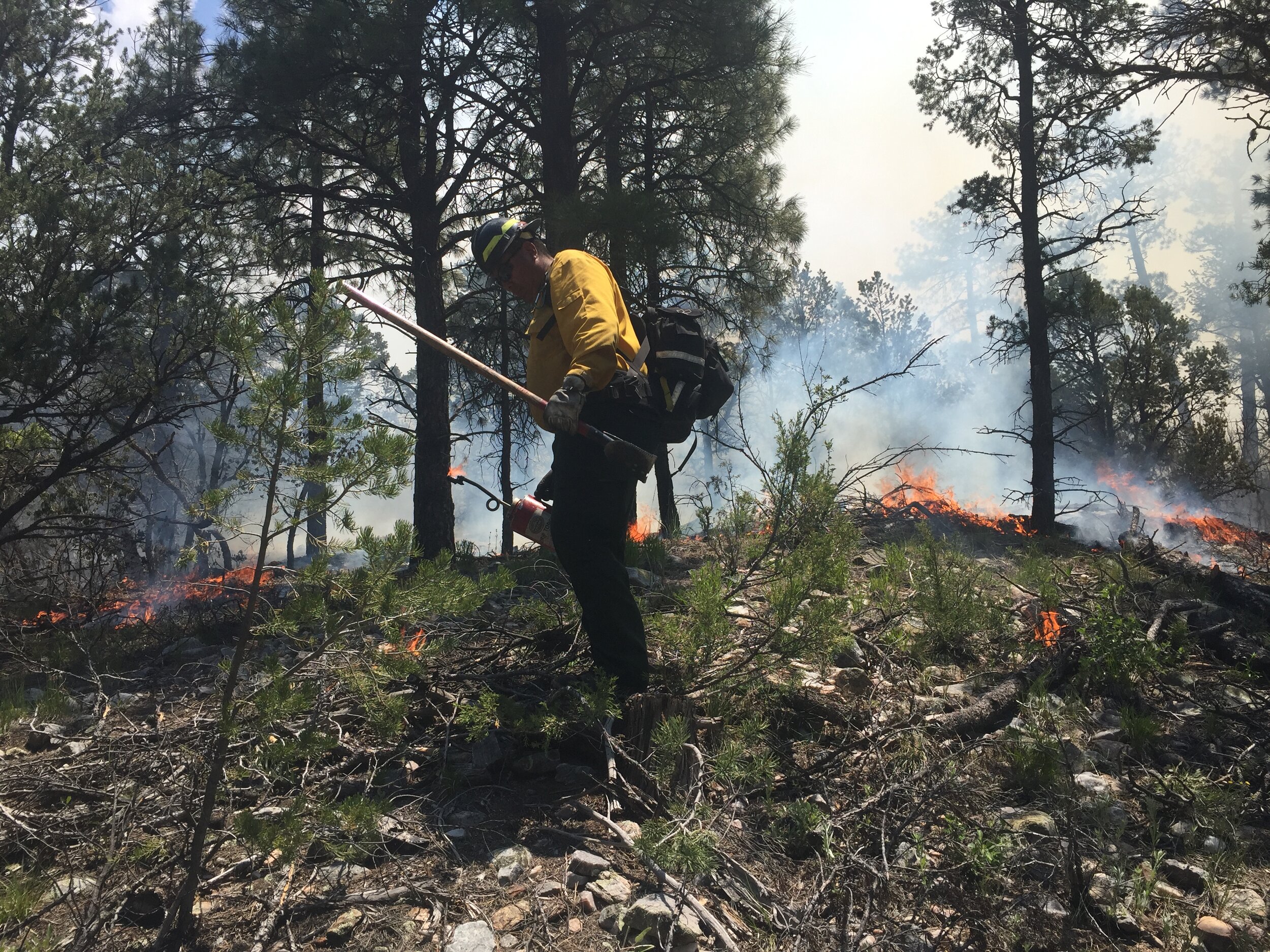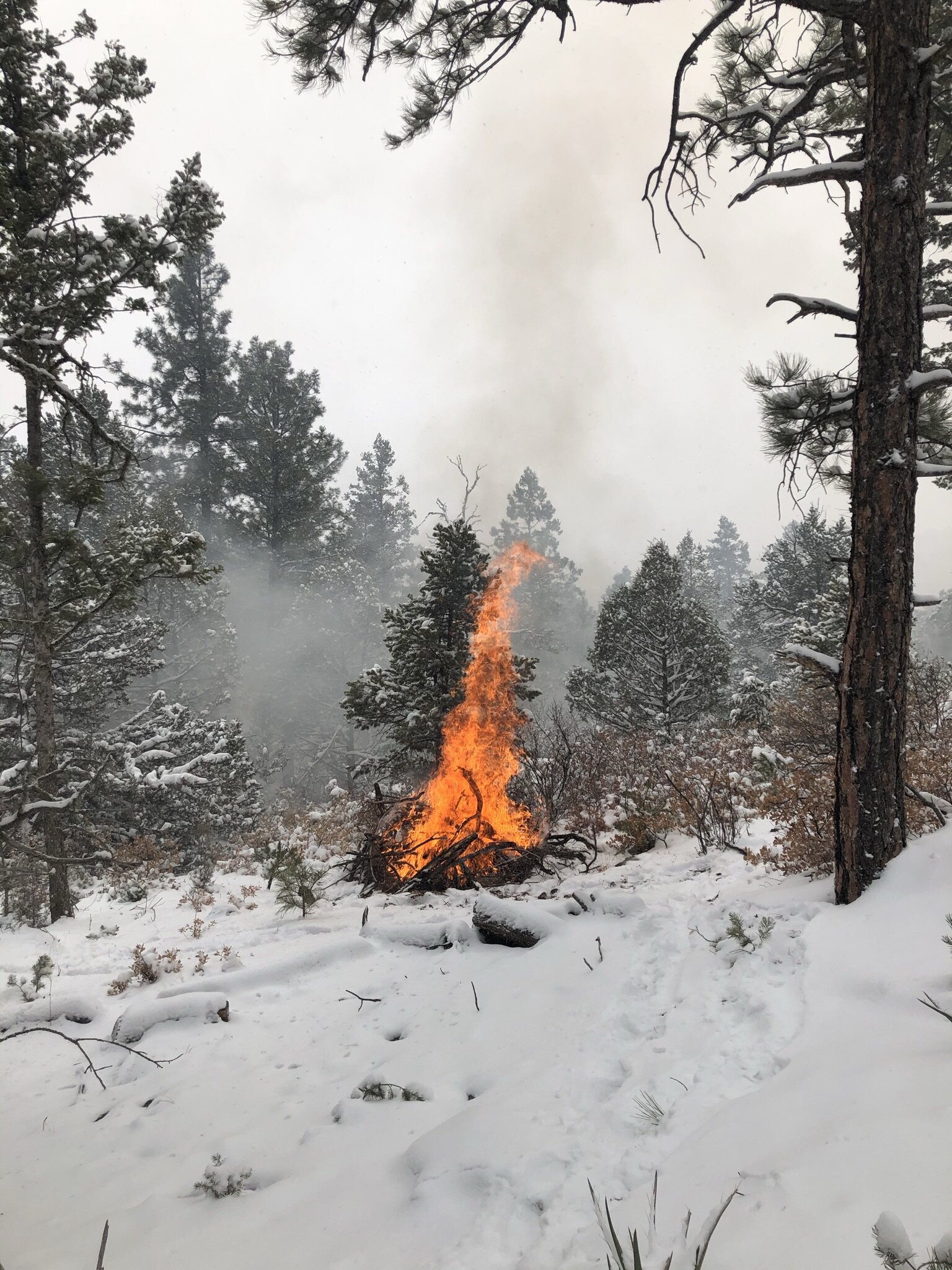Hello FACNM community!
Happy Wednesday, we hope you’re enjoying this cooler weather and the start to Fall here in Northern New Mexico! With Fall comes the start of another season; prescribed fire season. Fire adapted forests historically experienced low-severity wildfire in a way that protected them from widespread mortality and land-type conversion across large acreages. While it is essential that we put fires out to protect our homes and communities, our effectiveness at putting fires out over the last 100 years or so has largely removed fire from these forests. To reintroduce low-severity fire, land managers across New Mexico use prescribed fire under carefully planned conditions that typically align with Fall weather. Keep reading to learn more!
This Wildfire Wednesday features information on:
What are prescribed/controlled burns?
Effects of prescribed fires
Lessons learned on prescribed burning from the Southeastern US
An upcoming pile burning workshop opportunity
Have a great week!
Liz
Prescribed burns
What is a prescribed burn?
“Prescribed fires, also known as prescribed burns or controlled burns, refer to the controlled application of fire by a team of fire experts under specified weather conditions to restore health to ecosystems that depend on fire.” (Forest Service)
What are the outcomes of a prescribed burn?
From the Forest Service:
Photo from an All Hands All Lands prescribed burn in 2019
Reduces hazardous fuels, protecting human communities from extreme fires;
Minimizes the spread of pest insects and disease;
Removes unwanted species that threaten species native to an ecosystem;
Provides forage for game;
Improves habitat for threatened and endangered species;
Recycles nutrients back to the soil; and
Promotes the growth of trees, wildflowers, and other plants.
What are the types of prescribed burns?
Photo from an All Hands All Lands pile burn in 2021
Broadcast burning: “Broadcast burning involves fire applied across a predetermined area ranging in size from an acre or less to tens of thousands, generally after an area has not received precipitation for some amount of time to encourage fire movement” (NW Fire Science Consortium)
Understory burning: “A prescribed fire ignited under the forest canopy that focuses on the consumption of surface fuels but not the overstory vegetation. Underburning is generally used following a pre-treatment such as thinning and /or pile burning to further reduce the surface fuels, help maintain the desired vegetation conditions and enhance the overall health and resiliency of the stand.” (Bureau of Land Management)
Pile burning: “A prescribed fire used to ignite hand or machine piles of cut vegetation resulting from vegetation or fuel management activities. Piles are generally burned during the wet season to reduce damage to the residual trees and to confine the fire to the footprint of the pile. Pile burning allows time for the vegetative material to dry out and will produce less overall smoke by burning hot and clean.” (Bureau of Land Management)
Jackpot burning: “A modified form of underburn or broadcast burn where the target fuels to be ignited are the concentrations (or jackpots) of vegetative fuel. The result is a mosaic burn pattern. This technique works well when surface fuels loading is very high following vegetation treatments such as juniper encroachment removal used to improve rangeland ecosystems.” (Bureau of Land Management)
Cultural burning: Cultural burnings have been performed by aboriginal and indigenous peoples across the world for millennia and are practiced by many tribes today. These burnings can have many different objectives but what sets cultural burnings apart from other prescribed fires it that the cultural burnings and the resources they affect are “pertinent and substantial to their cultural livelihood”. Visit last week’s Wildfire Wednesday blog to learn more!
How are prescribed burns planned?
“Specialists write burn plans for prescribed fires. Burn plans identify – or prescribe – the best conditions under which trees and other plants will burn to get the best results safely. Burn plans consider temperature, humidity, wind, moisture of the vegetation, and conditions for the dispersal of smoke. Prescribed fire specialists compare conditions on the ground to those outlined in burn plans before deciding whether to burn on a given day.” (Forest Service)
Effects of prescribed fires
There are many public concerns regarding prescribed fires, particularly around air quality and wildlife, but the benefits of prescribed fires far outweigh any negative side effects. Click on the resources below to learn more about how prescribed fire effects these areas of concern.
Wildlife: Effects of Prescribed Fire on Wildlife and Wildlife Habitat in Selected Ecosystems of North America
Air quality: FIRE FAQs- Air quality impacts from prescribed fire and wildfire: How do they compare?
Wildfire regimes: Check out the webinar below from Dr. Molly Hunter of the USGS SW Climate Adaption Science Center to learn more.
“Prescribed fire can result in significant benefits to ecosystems and society. Examples include improved wildlife habitat, enhanced biodiversity, reduced threat of destructive wildfire, and enhanced ecosystem resilience. Prescribed fire can also come with costs, such as reduced air quality and impacts to fire sensitive species. To plan for appropriate use of prescribed fire, managers need information on the tradeoffs between prescribed fire and wildfire regimes. In this study, we argue that information on tradeoffs should be presented at spatial and temporal scales commensurate with the scales at which these processes occur and that simulation modeling exercises should include some realistic measure of wildfire probability. To that end, we synthesized available scientific literature on relationships between prescribed fire and wildfire regimes, and their associated ecological and societal effects, focusing specifically on simulation modeling studies that consider wildfire probability and empirical and modeling studies that consider prescribed fire and wildfire regimes at spatial and temporal scales beyond individual events.”
Lessons learned from the Southeastern US
Although we typically hear more about wildfires and prescribed burns occurring in the Western US, there are approximately 45,000 wildfires in the Southeastern US each year. From 1998 to 2018, about 70% of all prescribed burns in the United States occurred in the Southeast (Kolden, 2019). To learn more about fire in the Southeast visit the Wildland Fire in the Southeast webpage.
Why is the Southeast so far ahead in their utilization of prescribed burns? While in the Western US the approach of fire suppression was widely practiced, European settlers in the Southeast learned prescribed burning from the indigenous people and integrated that into their own relationship with the land. Prescribed burning, and selective logging, have been culturally accepted by communities in the Southeast and have been a part of land management since its early inhabitance. Learn more about the history of prescribed burning in the Southeast by reading this paper: The Historical Foundations of Prescribed Burning for Wildlife: a Southeastern Perspective.
To learn more about how Western states are learning from Southeastern fire practices check out:
This article from NPR: “Why The South Is Decades Ahead of the West in Wildfire Prevention”
This paper from the journal Fire: “We’re Not Doing Enough Prescribed Fire in the Western United States to Mitigate Wildfire Risk”



